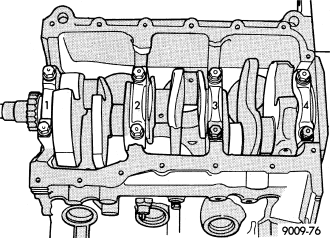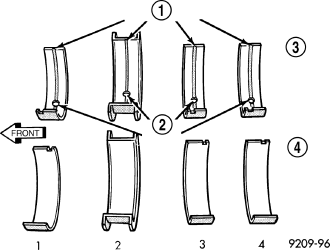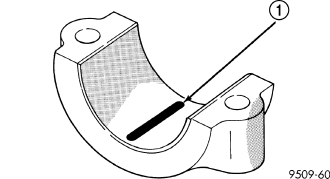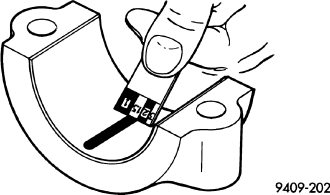STANDARD PROCEDURE - MAIN BEARING FITTING
Bearing caps are not interchangeable and should be marked at removal to insure correct assembly . Upper and lower bearing halves are NOT interchangeable.
Lower main bearing halves of 1, 3 and 4 are interchangeable. Upper main bearing halves of 1, 3 and 4 are interchangeable.

Upper and lower number 2 bearing halves are flanged to carry the crankshaft thrust loads and are NOT interchangeable with any other bearing halves in the engine .
All bearing cap bolts removed during service procedures are to be cleaned and lubricated with engine oil before installation. Bearing shells are available in standard and the following undersizes: 0.025
mm (0.001 in.) and 0.254 mm (0.010 in). Never install an undersize bearing that will reduce clearance below specifications.

CRANKSHAFT BEARING OIL CLEARANCE
Inspect the crankshaft bearing journals.
Engine crankshaft bearing clearances can be determined by use of Plastigage or the equivalent. The following is the recommended procedures for the use of Plastigage with the engine in the vehicle
or engine on a repair stand.
PLASTIGAGE METHOD—ENGINE IN-VEHICLE
NOTE:
The total clearance of the main bearings can only be determined with the engine in the vehicle by removing the weight of the crankshaft. This can be accomplished by either
of two following methods:
1.
Preferred method:
-
Shim the bearings adjacent to the bearing to be checked in order to remove the clearance between upper bearing shell and the crankshaft. This can be accomplished by placing a minimum of 0.254
mm (0.010 in.) shim (e. g. cardboard, matchbook cover, etc.) between the bearing shell and the bearing cap on the adjacent bearings and tightening bolts to 14–20 Nm (10–15 ft. lbs.).
-
When checking #1 main bearing shim #2 main bearing.
-
When checking #2 main bearing shim #1 & #3 main bearing.
-
When checking #3 main bearing shim #2 & #4 main bearing.
-
When checking #4 main bearing shim #3 main bearing.
NOTE:
Remove all shims before reassembling engine.
2.
Alternative Method:
-
Support the weight of the crankshaft with a jack under the counterweight adjacent to the bearing being checked.
3.
Remove oil film from surface to be checked. Plastigage is soluble in oil.
NOTE:
The 3.8L engine may be equipped with any number or combination of standard forged rod cap or cracked cap connecting rods. The connecting rods are interchangeable but require
a different tightening specification
(Refer to 9 - ENGINE - SPECIFICATIONS).
4.
Place a piece of Plastigage across the entire width of the bearing shell in the cap approximately 6.35 mm (1/4 in.) off center and away from the oil holes .
(In addition, suspected areas can be checked by placing the Plastigage in the suspected area). Torque the bearing cap bolts of the bearing being checked to the proper specifications.
5.
Remove the bearing cap and compare the width of the flattened Plastigage with the scale provided on the package. Locate the band closest to the same
width. This band shows the amount of clearance in thousandths. Differences in readings between the ends indicate the amount of taper present. Record all readings taken.
(Refer
to 9 - ENGINE - SPECIFICATIONS) Plastigage generally is accompanied by two scales. One scale is in inches, the other is a metric scale.
NOTE:
Plastigage is available in a variety of clearance ranges. Use the most appropriate range for the specifications you are checking.


PLASTIGAGE METHOD—ENGINE OUT-OF-VEHICLE
1.
With engine in the inverted position (crankshaft up) and mounted on a repair stand, remove main journal cap.
2.
Remove oil from journal and bearing shell.
3.
Cut Plastigage to same length as width of the bearing and place it in parallel with the journal axis .
4.
Carefully install the main bearing cap and tighten the bolts to specified torque
(Refer to 9 - ENGINE - SPECIFICATIONS).
CAUTION:
Do not rotate crankshaft or the Plastigage will be smeared.
5.
Carefully remove the bearing cap and measure the width of the Plastigage at the widest part using the scale on the Plastigage package . Refer to Engine
Specifications for proper clearances
(Refer to 9 - ENGINE - SPECIFICATIONS). If the clearance exceeds the specified limits, replace the main
bearing(s) with the appropriate size, and if necessary, have the crankshaft machined to next undersize.




